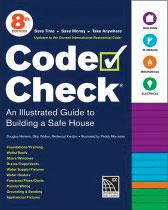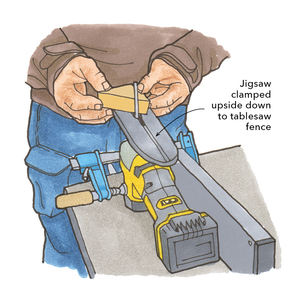Podcast 227: Cracked Beams, Missing Inspections, and Garage Insulation
Justin, Rob, and Patrick hear from listeners about membrane roofing, handyman businesses, and lighting controls before taking listener questions about cracked structural members, a missing electrical inspection, and what to do about hard water.
Follow the Fine Homebuilding Podcast on your favorite app. Subscribe now and don’t miss an episode:
 |
 |
Commercial roofer Dyami Plotke offers feedback and an alternative to underperforming low-VOC membrane adhesive and the likely problems when roofs transition from steep to low-slope. Sean emails to describe his experience getting web leads for his handyman business. Ryan describes his experience with smart bulbs and wireless light switches. Joe told his wife that the cracked beam holding the porch was nothing to worry about. Now he’s asking the crew their thoughts. Tom’s contractor and electrical subcontractor failed to get a rough-in inspection. He’s wondering if this is a problem when it’s time to sell the house. Justin from New Jersey asks for help converting his basement garage into living space and Jeff asks about water hardness.
Listener Feedback:
Listener feedback #1
Dyami from Long Island, NY (Roof Services) writes, Gentleman, As you correctly predicted in The Odd Assortment of Building Envelope Scenarios (Episode #215) I do listen and I heard Justin’s tale of installing EPDM on his porch roof with a combination of excitement and utter frustration. I share Justin’s frustration with the current state of low VOC bonding adhesive in the Northeast. When the switch was made to low VOC bonding a few years ago it was immediately noticed that the low VOC was dramatically worse smelling then the old high VOC glue.
This smell, coupled with the long required open time (often 45 minutes to an hour in colder temperatures) has led most commercial firms to abandon standard bonding adhesive and switch to newer spray applied adhesives. These newer adhesives are low VOC, extremely low odor and have a flash time of 5 to 10 minutes in cold temperatures. They only cost about 5% more per installed square foot) and require about $300 worth of application equipment versus a standard paint roller. That said it’s absolutely amazing to quickly and securely glue down EPDM in mid-20-degree temperatures.
Regarding Justin’s roof he mentioned that the reason for replacing the crappy roll roofing was due to an occasional leak where the flat roof met the shingle roof. This tie in doesn’t really relate to the type of roof membrane, but to the how the flat roof material is connected to the shingle roof material. That is to say, how the waterproof membrane ties into the water shedding surface. Could Justin elaborate how this was done as it’s arguably the most important part of his new porch roof.
Thank you and keep up the half-informed discussion of flat roofing.
Related links:
Listener feedback #2

HomeAdvisor, Handy, and others are platforms that homeowners can use to post or request that jobs be done. Largely, those companies/businesses aren’t worth it, as they make their money by charging fees to the contractor per lead, or pay the contractor very low wages as a sub.
Take Handy, for example, which I have experience with. I will include a few screen shots of their app, but the prices that they will pay to do things are 1/3rd or less than what I would actually charge to do the job. I’ve done a few things through them which fall directly in my wheelhouse or when I needed money for gas so I could make it to estimates and jobs that actually pay real money. They don’t provide the contractor with much information and you cannot contact the customer until 24hours before the job is scheduled to start. In short, those services have a place in the market, but will never be as good as going directly to a handyman business that does everything in-house.
Listener feedback #3
Ryan from Attleboro, Massachusetts writes, Afternoon guys, Just finished listening to episode 216 and I can sympathize with Matt and his lack-of-light-switch-ugly-as-heck-ceiling-fan situation. We recently bought a house with a similar thing going on and I’d like to fill you in on my solution:
I found the amount of work necessary vs the reward of adding new switches difficult to justify so I installed some new ceiling light fixtures and then Philips Hue bulbs and switches. Yes, there are other “smart” bulbs on the market, but the Hue won out for our house for a number of reasons:
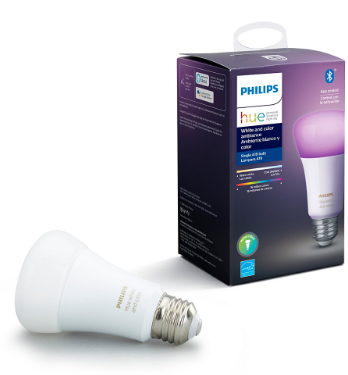 1) Color. Patrick and his concern for color temperature of LED bulbs is mostly a thing of the past as many manufacturers now offer LED bulbs in multiple temperatures (yes, even at the big box stores) The Hue bulbs come in three different versions: White, White Ambiance, and White and Color Ambiance. The White is a traditional soft white color, the White Ambiance goes from warm white to cool and the White and Color is the Hue bulb you’re likely familiar with that offers 16 million colors or something silly like that. We opted for the White Ambiance so we can adapt the color for the time of day and use of the space- warm soft white light in the kitchen at night, bright cool white while cooking dinner.
1) Color. Patrick and his concern for color temperature of LED bulbs is mostly a thing of the past as many manufacturers now offer LED bulbs in multiple temperatures (yes, even at the big box stores) The Hue bulbs come in three different versions: White, White Ambiance, and White and Color Ambiance. The White is a traditional soft white color, the White Ambiance goes from warm white to cool and the White and Color is the Hue bulb you’re likely familiar with that offers 16 million colors or something silly like that. We opted for the White Ambiance so we can adapt the color for the time of day and use of the space- warm soft white light in the kitchen at night, bright cool white while cooking dinner.
2) Switch
3) Smart functions. The smart bulbs are a great way to step foot into a “smart” home without going overboard in my opinion. You can make sure your lights are off when you’ve left the house or turn the lights on as you head home so that you don’t have to go home to a dark house. Many of the smart bulb manufacturers also offer a “vacation” mode that will cycle the lights in your house on and off between set hours to make it appear as someone is home when you’re not- much like the light timers of old.
and there you have it. I know Patrick would never consider spending the money on a Hue setup but I would very much encourage Matt to give it a look. Thus far everyone that has come into the house and used the lights and switches I installed has been impressed with the ease of use and look. I was quite happy to screw in a bulb and two small screws to mount the switch and call it a wrap on a project that could have stretched on far longer.
Thanks for your time and thank you for the podcast. I look forward to listening all the time.
Related links:
Editor’s Projects:
Rob on Fine Homebuilding’s Facebook post:
- Steve: Crappy framing, out of plumb and not level, then crappy drywall installation and finishers just go with it…then I try to hang my cabinets. Once saw a piece of rebar through the slab at the base of a wall, the finishers left it, the framers notched the sill, the drywall hangers notched the drywall, the finishers went around it, the finish guys notched the base board, the tile guys notched the tile. It took a cabinet maker to grab a sawzall and cut it off.
- Adam: Garbage framing. If there is one single item that boost quality and morale on a project, more than any other, it’s an excellent frame job.
- Bo: Buried electrical junctions.
- Brian: Drip edge right against the fascia board with no gap so the DRIP edge can actually do what it’s designed for
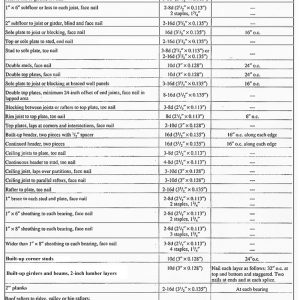
In the last episode #226, Bill from Colorado asked if he could use smaller nails to fasten the bottom plate to his I-joist floor system. The Trus Joist guides say you need a .135 in. diameter nail in this location. Problem is gun nails are .131. You can get thicker nails, but they are longer and require a larger nailer.
At first I thought this was just an exercise in shopping, but I couldn’t find a nail that met the specs, so I called Trus Joist tech support and talked to Brent. Brent didn’t know the answer, but he said he’d called me back. When we recorded the last show I hadn’t heard back. But I did a few hours later.
Justin’s bathroom work
Question 1: How can I tell if a beam with a crack down the middle is still structurally sound?
Joe writes, Hey FHB Crew, When my wife and I bought our house about a year ago I saw a crack in the beam holding up the porch roof. My wife wondered if we would have to repair it, and I told her it would be fine. The truth is I’m not really sure, I’m just going “by eye”. Are there any guidelines you can offer for splits, cracks, knots, notches, holes, etc. and how to repair them?
Related links:
Question 2: Is there any way to get a final approval if a contractor moved forward with missing rough-in inspections?
Tom writes, Dear FHB folks; What would you have done in this situation, or what would you suggest at this late date?
In 2015/16 a reputable contractor build a house for us. Somehow, a rough-in inspection was not done – which we learned during final inspection. At that point the inspector said the only permit (sticker) that could be issued was a yellow one (vs green) indicating that no rough-in inspection was done. I also received a letter from the Electrical Commissioner saying that I needed to inform my insurance agent and any prospective buyers of this status.
In the analysis of how this happened, we learned that, according to long practice, the contractor notified the inspector of the rough-in readiness, waited a week or so, then went forward with further construction. Although we did see documentation of this notification, the inspection was not done nor even attempted and no rough-in permit was posted. (that inspector has since found other employment). Clearly there was some culpability for the contractor and our electrician for not realizing no RI inspection was done. There was lots of finger pointing but the EC prevailed.
We then tried to organize a “forensic rough-in”. We provided dozens of pictures taken of the open walls specifically showing electrical elements. I had these taken during construction for future reference. Our basement has dropped ceilings so all the electrical to and from the main box was exposed for inspection. We used a remote camera to look at wires in walls that were covered. All of this made no difference to the opinion of the inspector (and the Electrical Commissioner who was also involved) as to the lack of a RI inspection.
So, we still have a yellow sticker on our breaker box and the letter from the EC detailing our obligations to notify. We have notified our insurance agent and will not have any impact to our rates or coverage. Although we don’t plan to sell in the foreseeable future we are not comfortable with the implications of the yellow sticker. What might we have done or could still do, to resolve this – short of opening up all walls for a traditional rough-in inspection? Is there really no room for negotiation in a matter like this?
Thanks for any advice you can offer
Related links:
Question 3: Is an insulated double-stud wall overkill when converting a garage to living space?
Justin from NJ writes, Good afternoon, I absolutely love the show and the magazine! I have been stressing about this upcoming project, and I want to make sure I do it right. My house is a split level, built-in 1960 and is poorly insulated. My wife and I have our first child on the way in May and I wanted to convert the garage to have more living space (no worries, workshop is going into the basement!). I want to insulate the garage the best way I can and I was thinking of a double-wall, but I am concerned with the vapor permeability. It is a slab-on-grade garage with three sides of the garage being exterior walls. The walls are 8 feet tall with cinder blocks going up halfway and the remainder being standard 2×4 walls.
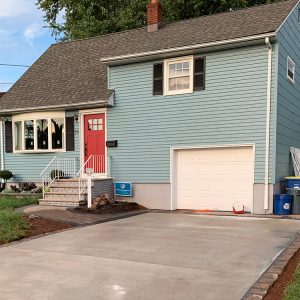 |
 |
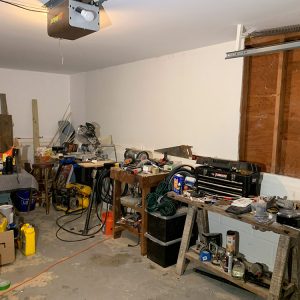 |
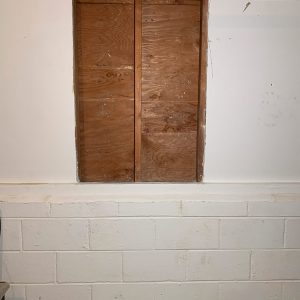 |
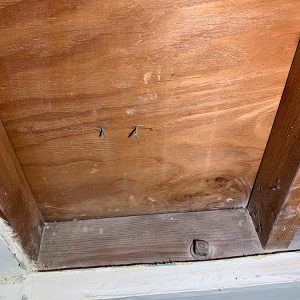 |
The layers of the wall go from exterior cement shingles, tar paper, 1/2-inch plywood then 2×4. My thought was to put a 2-inch thick XPS foam board in the cavities and seal them in with canned spray foam. Then I would build a double wall (which I need to cover the cinder blocks) and then fill it in with blown-in cellulose. I keep reading differing opinions on vapor permeability and condensation building up on the inside of the plywood. My thought is that if I have 2 inches of XPS that would stop any moisture from building up on the plywood. I have seen no water damage on the inside of the wall and the garage stays dry. The main wall is facing Northeast and I am in climate zone 5. Lastly, what is the minimum thickness of rigid foam you would install on the floor?
Thank you so much for helping out with this, I just need the help of the experts.
Related links:
Question 4: What are the effects of hard water on a home’s water system and appliances?
Jeff from North Carolina writes, In a discussion on the latest episode, Patrick made a brief comment about having hard water. We recently had our well water tested and the hardness score was a 10. Can you elaborate a little more on the effects of hard water on a home and maybe comment at what point it makes sense to invest in a softener system. Thank you for the podcast!
Related links:
End Notes:
Appeal for water quality expert?
Can somebody contact us about writing an article on water problems?
And we’re still trying to find somebody to talk about evaporative coolers.
If you have any questions you would like us to dig into for a future show, shoot an email our way: [email protected].
If we use your question we’ll send you a FHB Podcast sticker!
 #KeepCraftAlive
#KeepCraftAlive
KeepCraftAlive hats help celebrate the value of true craftsmanship–plus 50% of all proceeds from every hat sold go to the #KeepCraftAlive Scholarship Fund, supported by Fine Homebuilding and SkillsUSA.
Buy a #KeepCraftAlive hat or t-shirt
This episode is brought to you by Huber Engineered Woods, makers of AdvanTech and ZIP System products.
The Prove Tour product experience is coming to a lumber yard near you. Huber Engineered Woods fleet of traveling hands-on product demonstrations is hitting the road soon for lumberyard events across the country. Try ZIP System liquid flash, Zip System stretch tape, and AdvanTech subfloor adhesive in an immersive product experience. For event details, check out the stories and highlights on @huberwood on Instagram profile each week or ask your local Huber rep about a local “Prove It Tour” event near you.
Fine Homebuilding podcast listeners can now get 20% off anything in the Taunton store, including the Code Check series. These sturdy, spiral bound reference books will help you navigate the International Residential Code, The National Electric Code and the Universal Plumbing Code. Use the discount code FHBPODCAST to take advantage of this special offer.
We hope you will take advantage of a great offer for our podcast listeners: A special 20% off the discounted rate to subscribe to the Fine Homebuilding print magazine. That link goes to finehomebuilding.com/podoffer.
The show is driven by our listeners, so please subscribe and rate us on iTunes or Google Play, and if you have any questions you would like us to dig into for a future show, shoot an email our way: [email protected]. Also, be sure to follow Justin Fink and Fine Homebuilding on Instagram, and “like” the magazine on Facebook. Note that you can watch the show above, or on YouTube at the Fine Homebuilding YouTube Channel.
The Fine Homebuilding Podcast embodies Fine Homebuilding magazine’s commitment to the preservation of craftsmanship and the advancement of home performance in residential construction. The show is an informal but vigorous conversation about the techniques and principles that allow listeners to master their design and building challenges.
Other related links
-
- All FHB podcast show notes: FineHomebuilding.com/podcast.
- #KeepCraftAlive T-shirts and hats support scholarships for building trades students. So order some gear at KeepCraftAlive.org.
- The direct link to the online store is here.


